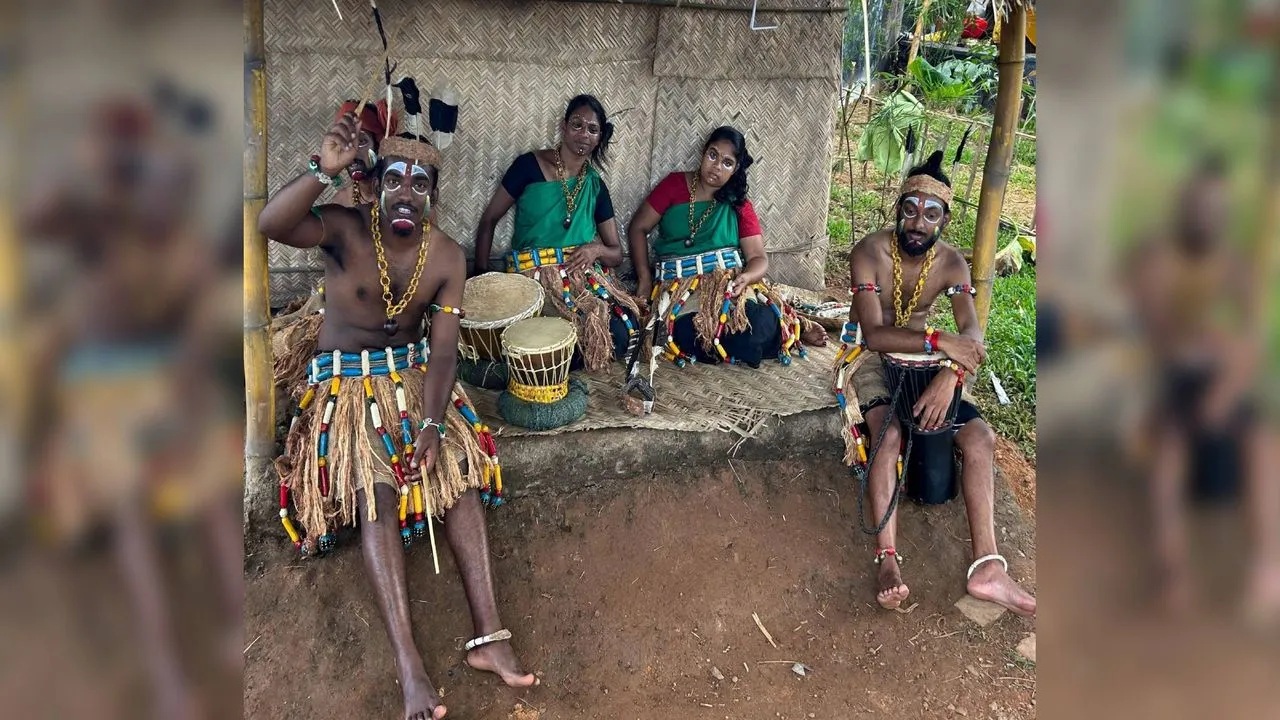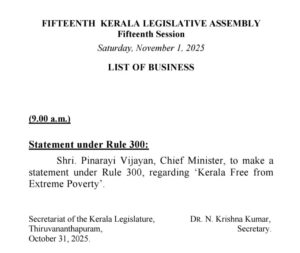When Chief Minister Pinarayi Vijayan makes the declaration at the Central Stadium in Thiruvananthapuram, Kerala will be the first Indian state to be free of extreme poverty.
Published Oct 31, 2025 | 4:49 PM ⚊ Updated Oct 31, 2025 | 6:49 PM

The Adivasi Gothra Mahasabha accused the government of turning the declaration into a 'political spectacle.' Pictured, members of the Paliyar tribe, 'exhibited' in Thiruvananthapuram as part of the state government's Keraleeyam celebrations in 2023. (File pic)
Synopsis: A group of eminent personalities issued an open letter, questioning the government’s claim and urging that the full report and survey methodology be made public. The government must clarify whether the term ‘extreme poverty’ is simply a rebranding of ‘destitution,’ they demanded.
A storm of criticism is rising in Kerala even as the government is making elaborate plans to declare the state “extreme poverty-free” on Saturday, 1 November, coinciding with the Kerala Piravi — or the State Formation Day.
When Chief Minister Pinarayi Vijayan makes the declaration in the Kerala Legislative Assembly, the state will be the first in India to be free of extreme poverty.
While the Left Democratic Front (LDF) government calls it a milestone in Kerala’s social development journey, a section of economists, social scientists, and Adivasi groups is accusing the government of manipulating definitions, data, and narratives to paint a rosy picture ahead of the upcoming local body and Assembly elections.
The controversy gained momentum after a group of eminent personalities issued an open letter, “Extreme Poverty-Free Kerala or Destitute-Free Kerala?”. The signatories included educationist RVG Menon, economists MA Oommen and KP Kannan, and former Additional Director General of the Central Statistical Organisation, G Ravindran.

Chief Minister Pinarayi Vijayan will declare Kerala free of extreme poverty on Saturday.
They questioned the government’s claim and demanded that the full report and survey methodology be made public. “The government must clarify whether the term ‘extreme poverty’ is simply a rebranding of ‘destitution, ’” the letter demanded.
It also sought details of the parameters used to identify the poor, the expert panel that supervised the process, and whether statutory agencies such as the State Planning Board and the Directorate of Economics and Statistics were consulted.
The experts pointed to glaring contradictions in official data.
“If Kerala has 5.9 lakh families with Antyodaya Anna Yojana (AAY) ration cards — meant for the poorest of the poor — how can the government now say only 64,006 families are extremely poor?” the letter asked.
The discrepancy, they said, raised concerns over whether the declaration was statistically robust or politically motivated.
The letter further recalled that the 2011 Census identified 4.85 lakh individuals in 1.16 lakh Adivasi families living in extreme poverty.
“If those numbers have drastically fallen, the government must show the evidence,” it added.
The Adivasi Gothra Mahasabha, led by KR Reshma and M Geethanandan, accused the government of turning the declaration into a “political spectacle.”
They criticised the decision to feature film stars Mammootty, Mohanlal, and Kamal Haasan at the declaration event, calling it an attempt to draw public sympathy ahead of elections.
In a joint statement, the Mahasabha said that the government’s data failed to capture the grim realities in tribal belts such as Wayanad and Attappady.
“Only five per cent of the identified families belong to Scheduled Tribes. This is a mockery when entire tribal hamlets remain landless, homeless, and jobless,” the leaders said.
They pointed to persistent malnutrition and infant mortality among tribal children — 59 percent underweight and more than half stunted — as proof that extreme poverty remains entrenched.
“Women have lost livelihoods due to mechanisation and the influx of migrant labour. The ground reality contradicts the state’s claim of eradicated extreme poverty,” they said.
Intensifying the row ahead of the government’s grand declaration, Leader of the Opposition VD Satheesan on Friday, 31 October, accused the LDF government of “building a palace of lies on false figures” to mislead the public before elections.
Addressing a media conference at Cantonment House, his official residence in Thiruvananthapuram, he alleged that the government’s claim of eradicating extreme poverty was “a statistical sleight of hand and a cruel joke on the poor.”
He questioned how the number of extremely poor families, listed as 4.5 lakh in the LDF’s 2021 election manifesto, had suddenly been reduced to 64,000 in the official count.
“What trick turned 4.5 lakh into 64,000? Are the remaining one lakh tribal families now living in prosperity?” he asked.
Citing Food and Civil Supplies Minister GR Anil’s statement in the Assembly that 5.91 lakh people hold AAY cards, he warned that declaring Kerala “extreme poverty-free” could jeopardise central assistance for these beneficiaries.
AAY cards are issued to the “poorest of the poor” families identified under the Public Distribution System. These typically include landless agricultural labourers, marginal farmers, rural artisans, slum dwellers, widows, elderly persons with no means of support, and disabled individuals in low-income households. The scheme ensures that these most vulnerable sections of society receive heavily subsidised food grains every month to combat hunger and malnutrition.
He also questioned whether the Planning Board or the Statistical Department had any role in preparing the list and accused the government of “using PR machinery and celebrity endorsements to whitewash poverty.”
Referring to Attappady and other tribal belts, the Opposition leader said the declaration “ignores the lived suffering of thousands who still lack food, shelter, and healthcare,” calling upon film stars invited to the event to “stay away from legitimising a government fraud.”
Facing mounting criticism, Local Self-Government Minister MB Rajesh on Friday defended the declaration, clarifying that the government’s claim was limited to eradicating extreme poverty, not all poverty.
“The extreme poor are those who have no access to food, health, safe housing, or income for survival — people who were not part of any welfare scheme and lacked documents like ration cards or Aadhaar. The government identified and extended survival support to them,” Rajesh explained.
He emphasised that the process was scientific, transparent, and long in the making.
“This is not a decision taken in the early hours of the morning. It was approved in the first Cabinet meeting of the second LDF government in 2021, followed by a detailed guideline. Experts who remained silent during the process are now raising questions,” he said.
Rajesh added that the chief minister would present a detailed report in the Assembly to counter the allegations.
He also dismissed claims that the achievement was a publicity stunt, saying, “Kerala’s model can inspire the rest of India. If the BJP wants credit, they should make other states extremely poverty-free.”
The Extreme Poverty Eradication Programme (EPEP), spearheaded by the Commissionerate of Rural Development, began as a unique initiative to identify the most deprived households.
The survey focused on four key deprivation categories: food, health, income, and shelter, aligned with the UN Sustainable Development Goals.
Initially, 1,18,309 households were nominated through a participatory process, from wards and divisions.
After multi-level scrutiny — including subcommittee reviews, field interviews via a mobile app, and super checks — 87,158 households were shortlisted, later reduced to 64,006 families comprising 1,03,099 individuals.
Of these families, 75 percent belonged to the general category, 20 percent to Scheduled Castes, and 5 percent to Scheduled Tribes. Around 81 per cent lived in rural panchayats.
District-wise, Malappuram had the highest number of extremely poor families (8,553), followed by Thiruvananthapuram. Kottayam recorded the fewest.
The survey found that 58,273 families suffered income deprivation, 40,917 faced health-related issues, 34,523 were deprived of food, and 15,091 lacked shelter — with several families experiencing multiple forms of deprivation.
Subsequently, each local body prepared an Extreme Poverty Sub-Plan, detailing micro-level interventions to address these needs.
Kudumbashree, the State Poverty Eradication Mission, assisted in implementing and monitoring these plans. District Planning Committees approved the projects, ensuring decentralised execution.
Among the identified families, 7,484 were landless and homeless, and 8,629 were without any form of housing.
As Kerala prepares to celebrate its “historic achievement” on Kerala Piravi Day, the state stands divided between celebration and scepticism.
To the government, the declaration reflected its commitment to inclusive governance and grassroots development. But to critics, it risked becoming a symbolic gesture, hiding the lived realities of those still struggling on the margins — especially the tribal communities who feel excluded from the narrative.
As the Assembly session convenes for the grand announcement, the core question lingers: Has Kerala truly eradicated extreme poverty, or merely redefined it for political gains?
(Edited by Majnu Babu).
